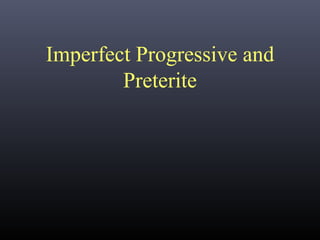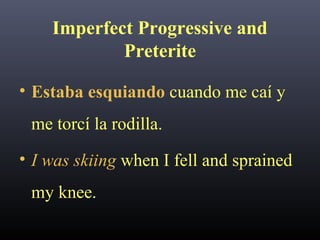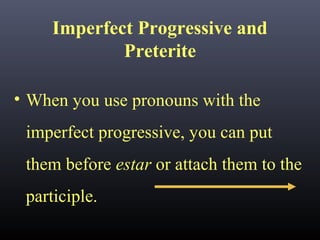Imperfect Progressive
- 1. Imperfect Progressive and Preterite
- 2. Imperfect Progressive and Preterite âĒ Do you remember the present progressive? âĒ Itâs used when a person wants to say that an action is happening âright now.â
- 3. Imperfect Progressive and Preterite âĒ It uses the present tense of estar + the present participle. âĒ No puedo ir al cine. Estoy estudiando para el examen.
- 4. Imperfect Progressive and Preterite âĒ To describe something that was taking place over a period of time in the past, use the imperfect progressive, which uses the imperfect tense of estar + the present participle.
- 5. Imperfect Progressive and Preterite âĒ Estaba esquiando cuando me caà y me torcà la rodilla. âĒ I was skiing when I fell and sprained my knee.
- 6. Imperfect Progressive and Preterite âĒ The present and imperfect progressive tenses use the same irregular present participles.
- 7. Imperfect Progressive and Preterite âĒ Remember, to form the present participle of -ir stem-changing verbs, e changes to i and o changes to u:
- 8. E>I decir? seguir? diciendo siguiendo pedir? servir? pidiendo sirviendo repetir? vestir? repitiendo vistiendo
- 10. I>Y âĒ For the following -er verbs, the I of -iendo changes to y: âĒ creer? âĒ creyendo âĒ traer? âĒ leer? âĒ trayendo âĒ leyendo
- 11. Imperfect Progressive and Preterite âĒ When you use pronouns with the imperfect progressive, you can put them before estar or attach them to the participle.
- 12. Imperfect Progressive and Preterite âĒ ÂŋQuÃĐ estaba haciendo cuando te cortaste? âĒ Estaba afeitÃĄndome. âĒ Or âĒ Me estaba afeitando.
- 13. Imperfect Progressive and Preterite âĒ Note that the imperfect progressive describes what was taking place while the preterite tells a specific occurance in the past or interrupts the action.
- 14. Imperfect Progressive and Preterite âĒ Ella estaba corriendo cuando se lastimÃģ el tobillo.













